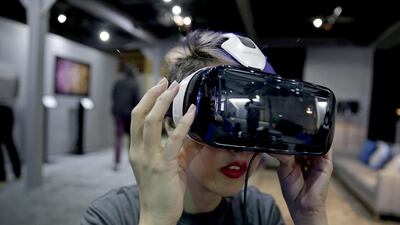Virtual reality is creeping into the real world. Once seen as a tool for alien-blasting gamers, now movie studios, television producers and artists are adopting the technology, which immerses people in faraway realms using bulky goggles, house-sized domes or even smartphones.
Entering a virtual world means that users who look left, right, up or down experience an alternate environment, even when they are sitting in a theatre or on a couch.
It means a horror movie can be promoted with a haunted house tour featuring a mass murderer who can spring from anywhere. Or a shark documentary enhanced by the sensation that you are in the water being circled by predators.
“What’s better for jump scares than turning your head and it’s right in your face?” says Matt Lipson, senior vice president of digital marketing at Focus Features.
It may be a while before virtual reality appears at your local multiplex but it is already being used to lure you there.
Universal's Focus Features recently launched its first virtual-reality film experience to promote the release of Insidious: Chapter 3 in the United States. It toured the country, inviting fans to wear virtual-reality goggles, and sent out thousands of movie-branded Google Cardboard kits, which fold around smartphones to turn them into primitive VR viewers. Fans can download an app to make it work.
In the Insidious VR experience, viewers sit in a haunted house across from a psychic. Various scares appear from the right and left and, in the end, there is a close-up encounter with an undead serial killer.
Lionsgate used a similar approach for the movie Insurgent in an attempt to widen the film's fan base beyond young women, to male fans of action movies. .
VR remains the realm of promotion – for now. But content created now or for future films could also build value for home-video products as sales of VR headsets increase, Lipson says.
The number of outlets for virtual reality is increasing. Oculus VR, the company Facebook bought for US $2 billion (Dh7.3b) and a leader in the VR headset market, is expected to start shipping a consumer version early next year. It has already sold 150,000 goggles as test units for content developers.
Samsung is selling Gear VR, which works with Galaxy S6 smartphones. Sony will release a consumer version of its Project Morpheus, which connects to its PlayStation 4, in the first half of next year.
Oculus’s goal is to get headsets into as many hands as possible, says co-founder and head of product Nate Mitchell. The company set up a division of experimental filmmakers called Oculus Story Studio to help filmmakers learn how to create VR video.
“Our goal is making the Rift [headset] and virtual reality affordable,” says Mitchell, adding that he hopes it “becomes a technology that truly changes the world”.
Facebook is testing what Mark Zuckerberg calls “spherical video”, a flat representation of immersive content that could be navigable by mouse on its website. Google’s YouTube launched support for “360-degree video” on Chrome browsers and Android phones in March and is providing VR camera rigs for its partners at its six studios. Fold-up Google Cardboard units can be bought online for as little as $2.46.
Discovery Communications is also planning to launch VR content under the Discovery Virtual brand in August. Teams are already shooting in the Bahamas in preparation for “Shark Week” in July.
Another virtual frontier to cross is creating environments for groups, not just individuals, in the same way that theatres provide a community experience.
That possibility was tested recently when eight art-school students gathered under a “Vortex dome” in downtown Los Angeles for an immersive show projected on a 19-foot-high hemisphere.
Student Jack Turpin used video game software to create a psychedelic world of rolling mountains, beaches and palm trees. Using a controller, he transported students through the environment as if they were riding in a tour bus with a bubble glass roof.
It’s all part of creating a new cinematic language that doesn’t just play out on the screen in front of you, but is interactive and immersive, said Prof Hillary Kapan, who put on the class for the California Institute of the Arts.
“What kind of elements do you use instead of an icon on a computer? How do you interact with that world?” he says. “We’re just in the beginning stages of understanding.”

